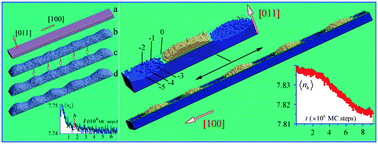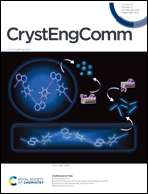Roughening transition as a driving factor in the formation of self-ordered one-dimensional nanostructures†
Abstract
Based on the kinetic Monte Carlo method, we investigated the formation mechanisms of periodical modulations arising along the length of one-dimensional structures. The evolution of initially cylindrical nanowires/slabs at temperatures lower than their respective melting temperatures can result either in breakup into single nanoclusters or in the formation of stable states with pronounced modulations of the cross section. We show that these modulations, excited in the ‘subcritical mode’ of wavelength λ < λcr = 2πrnw (rnw is the nanowire radius), correspond to the appearance of roughening transition on the quasi-one-dimensional surface of nanowires/slabs. The short-wavelength modulations of one-dimensional systems, as shown in our work, can be realized either by the proper orientation of the nanowire/slab axis, providing spontaneous appearance of roughening transition on its lateral surface, or by the method of activating the surface diffusion of atoms by an external impact (irradiation with an electron beam or contact with a cold plasma), which stimulates roughening transition without significant heating of the nanowire. For the cases of BCC and FCC lattices, we have demonstrated that it is possible to excite either metastable structures with a wavelength below the threshold of energetic instability, <4.5rnw, or unstable ones with substantially increased λ (λ ≳ 14rnw). The possibility of managing wavelengths of the long-wave perturbations makes it possible to control the distance between nanodroplets in the dynamic regime of nanowire breakup. The results obtained can be used in the controlled synthesis of ordered one-dimensional structures for applications in optoelectronics and ultra-large-scale integrated circuits.

- This article is part of the themed collection: Nanomaterials


 Please wait while we load your content...
Please wait while we load your content...